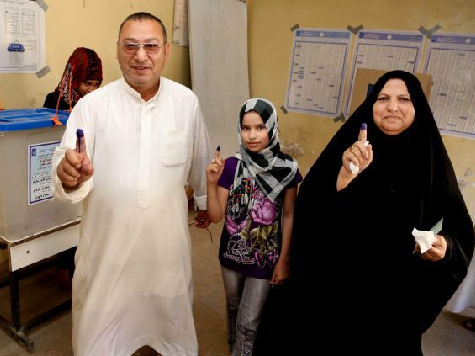
Iraqi citizens risk threats of violence and stringent security in order to cast a vote in the first parliamentary election since the U.S. withdrawal of troops from the country in 2011. Risk of violence plays a lesser role for Iraqi refugees still eligible to vote in Iraq’s elections, who recently cast their votes in El Cajon, California for the same parliamentary election.
Thousands of Iraqis headed to the polls within Iraq on Wednesday. Heavy security involved closure of Iraqi airspace, helicopters monitoring the capital, and road closures, according to an AP report. One particularly terrorist attack-prone area of Baghdad ferried voters to and from polls in double-decker buses. Despite heavy security measures, multiple bombings occurred on the day of the election. Over 3,000 in Iraq have died from violence in the first months of 2014.
A much different scene played out at polls stationed at the Crystal Ballroom in El Cajon on Sunday and Monday, when Iraqi refugees voted early in the parliamentary election. KPBS reported numbers of those voting in the hundreds. San Diego County hosts the second largest Iraqi refugee population in the U.S., with approximately 80,000 residents. Chaldean American Chamber of Commerce President Ben Kalasho informed KPBS that San Diego’s Iraqi refugees are made up of Chaldean Christians as well as Muslim and Kurdish persons.
Iraq’s current election is being held to fill 328 parliamentary seats from among 9,000 candidates. “Prime Minister Nouri al-Maliki, who has held power for eight years, faces growing criticism over government corruption and persistent bloodshed, as sectarian tensions threaten to push Iraq back toward the brink of civil war,” according to the AP report.
Voters in Iraq proudly brandished ink-stained fingers after casting their ballots. The United Nations Development Programme (UNDP) Procurement Guide for Elections In Post Conflict Countries directs the use of indelible ink in voter registration and voting on election day. The ink stains a voter’s finger for approximately 72 hours, aiming to prevent voter fraud, as election officials make sure new voters show unstained fingers.
Federal elections held in California currently require that “A voter can meet the proof of identity requirement by presenting either a current and valid photo identification or other acceptable document.” An “other acceptable document,” as outlined on the Secretary of State’s website, includes a health club ID, utility bill, or public transportation authority senior citizen discount card. These requirements only apply to federal elections. The Secretary of State notes, “all registrants shall be permitted to vote a regular ballot in all non-federal elections without showing ID.”
Meanwhile, a fight over voter ID laws rages on in a number of states across the nation. In Wisconsin a federal judge recently “struck down Wisconsin’s photo ID requirement for voting, concluding that the 2011 law passed to curb voter fraud unconstitutionally discriminates against blacks and Latinos,” according to the Wall Street Journal Law Blog. A diagram of voter photo ID requirements by state can be found on the National Conference of State Legislatures website.

COMMENTS
Please let us know if you're having issues with commenting.